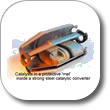The following Toyota factory bulletin refers to codes P0171 and P0174, lean conditions on either or both
banks, but this raises cause for concern when diagnosing catalytic converter codes as well. This bulletin is acknowledging there may be a problem with the Intake Air Control Valves on 2004 Camry, Sienna and
Solara vehicles with 3.3L (3MZ-FE) engines.
The same procedure prescribed in this factory publication should be performed before replacing any catalytic converter on one of the affected vehicles. The reason is that this potential vacuum leak may be causing higher than acceptable fuel trims, even if not high enough to set the P0171/P0174 codes which generally appear with fuel trims in excess of 25%.
False catalyst codes will often be set when combined fuel trims on either bank approach or exceed 10%. This is because the exhaust gas contains too much oxygen and not enough CO to react with the precious metals on the catalytic converter substrate. In these cases, the substrate may not get to operating temperature, or may cool down during the drive cycle.
This will allow the exhaust gas to pass both upstream and downstream O2 sensors “unchanged”, triggering a catalyst code (P0420/P0430). While it is true the catalytic converter was not operating, it would have likely been the fault of the exhaust mixture entering the converter, not the catalyst itself. Correct the mixture and the offending catalytic converter code(s) would very likely disappear as well.
Please see the bulletin below
Title:
M.I.L. "ON" DTC P0171 AND/OR P0174:
ENGINE RUNNING LEAN
Models:
04 Camry, Sienna & Solara (3MZ-FE)
August 4, 2004
Introduction
Some 2004 model year Camry, Sienna and Solara (3MZ-FE) vehicles may exhibit a M.I.L. "ON" condition with one or both of the following Diagnostic Trouble Codes stored as a result of a vacuum leak in the Intake Air Control Valve.
P0171 (System Too Lean [Bank 1])
P0174 (System Too Lean [Bank 2])
Applicable Vehicles

.
Repair Procedure:

1. Monitor the Bank 1 and Bank 2 Short Term Fuel Trim in the Data List.

2. Spray carburetor cleaner near the Intake Air Control Valve pivot shaft and monitor
Short Term Fuel Trim as indicated in step 1.
3. Was the short term fuel trim changing to a rich reading, or negative fuel trim in step 2?
If Yes - Replace the Intake Air Control Valve. Refer to the Technical Information System (TIS), 2004 model year applicable model Repair Manual: Intake: Intake Air Control Valve Assy No. 2 (3MZ-FE): Replacement.
After the Intake Air Control Valve has been replaced, proceed to step 4.
If NO - Check for other vacuum leaks or lean running conditions per Technical Information System (TIS), 2004 model year applicable model Repair Manual: Diagnostics: SFI System (3MZ-FE): P0171, P0172, P0174, P0175 System Too Lean.
4. Is the short term fuel trim now in the negative percent? Is the long term fuel trim returning closer to 0%?
If Yes - Clear short and long term fuel trims by disconnecting the negative battery cable for 90 seconds. Reconnect the negative battery cable and test drive the vehicle.
After the test drive, proceed to step 5.
If NO - Continue diagnosis for lean running conditions per TIS, 2004 model year applicable model Repair Manual: Diagnostics: SFI System (3MZ-FE): P0171, P0172, P0174, P0175 System Too Lean.
5. Confirm lean running condition has been eliminated (short term and long term fuel trims on All Data List are less than +/- 3% on both banks).






